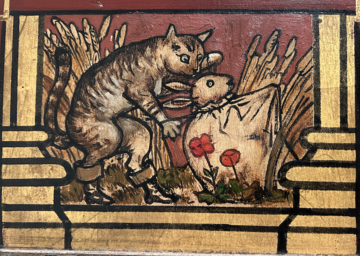‘THE WORLD RUBBED ITS EYES WITH ASTONISHMENT’

‘THE WORLD RUBBED ITS EYES WITH ASTONISHMENT’
The Ashmolean Museum sparks joy with its latest blockbuster exhibition about the Victorian revolution in colour.
Published: 20 September 2023
Author: Richard Lofthouse
Share this article
What a riot. The Ashmolean’s long renaissance continues with Colour Revolution, Victorian Art, Fashion and Design. Those last three words sound slightly calculated but they are not, and if you simply want a solid array of art you will not be disappointed. Neither do the curators get carried away with sound-tracks and tech gimmickry and smudgy touchscreens, of which there are none.
What you get is a simply brilliant, multi-layered portrait of Victorian Britain that is curated into a dazzling whole, bookended at one end by a drab ante-room with one of Queen Victoria’s actual mourning dresses, and at the other by lurid, absinthe-dipped decadence as we reach into the 1890s and touch the new century.
There is then also a secondary bookending of Victorian portrayals of Venice that could not be further removed from each other.
The first is by JMW Turner (1775-1851), Venice from the Porch of the Madonna della Salute. It is a bright, colour-saturated, stand-up depiction of the Grand Canal that connected up Medievalism, God and Madonna-coloured skies.

John Ruskin, when he was Slade Professor of Art at Oxford, said ‘You ought to love colour, and to think nothing quite beautiful or perfect without it.’
That quotation fires the starting gun on an exhibition that triumphally rages all over empire, archaeology, Darwinian insights into mating behaviour, the advent of travel and tourism, the exotic and also the discovery of Japan.
By the end, we have been carried right away from the moralistic colour of Ruskin to a deliberately off-colour and darker toned celebration of the decadent, as the aesthetic movement began to spurn magenta and mauve for russet and olive, while the morally suspicious yellow defined the 1890s and green roamed across a spectrum of meanings from arsenic-poisoning to youth.
And so the Venice of Turner is now met by the Venice of James Abbott McNeill Whistler (1834-1903), Nocturne: Blue and gold, St Mark’s, Venice. In this a Japanese-inspired indigo sky melts St Mark’s into a moody night. It could not be further removed from Turner yet – and surely this is part of the point – the paintings themselves are absolutely glorious. While they are present for additional reasons besides being glorious, glorious they are and nothing detracts from that for the purists who are still clinging to the last vestiges of l’art pour l’art.
But if we were to hang the exhibition on a single year it would be 1856, not the year of any particular work of art but the year in which the first aniline dye was produced commercially.
In George Field’s Chromatography (1871), Thomas Salter of chemistry fame wrote, ‘The world rubbed its eyes in astonishment; and truly it seemed almost as wonderful to produce the colours of the rainbow from a lump of coal, as to extract sunshine from cucumbers.’
And so this is the other side of the exhibition, which ranges across porcelain peacocks, hummingbird taxidermy blended into brooches and hair pieces, cardinal-coloured corsets, German libraries of synthetic dyes, the rarest book illustrations including some from the fifteenth century, and always this intricate, luminous research connecting our perception of the Victorians and the Victorians’ own many perceptions of other pasts including the ancient world and the re-imagining of Medievalism that drew partly from the Oxford Movement in theology but recast it in brilliantly coloured stained glass and Rossetti paintings, both present here to great effect.
Put it this way. If your memory of the Oxford debating union was squinting at the Pre-Raphaelite ceiling of the library and wondering with disappointment why it was so dingy, you’ll find a suitable riposte by visiting the Ashmolean in 2023.
Perhaps centrally, and what Ashmolean Director Dr Xa Sturgis accurately refers to as a coup de theatre, the museum imaginatively re-stages the London International Exhibition of 1862 in a very tall, spacious room that takes the centre piece of the show.
In this there is a tinted Venus (coloured wax modelled onto a marble statue of a naked woman) that caused an absolute outrage at the time because it brought colour and ‘life’ back to a marble statue, making it seem a bit pornographic to a generation whose prurience wasn’t just the stuff of fiction. It left far too little to the imagination. But it was also exploiting colour in ways that were new in 1862.

But for our money the prize exhibit in that room is the ‘monstrosity’ known as The Great Bookcase (1859-62) by William Burges, who collaborated with thirteen artists to paint numerous panels in a great fracas of colour and motif, pagan and Christian, here an Aesop fable and there a puss in boots, delightfully filed under the heading ‘Several playful details' (see left).
Burges displayed the enormous bookcase as the centrepiece of a Medieval Court in the 1862 Exhibition, to a very mixed response.
For that reason alone it hits all the buttons in 2023 because we live in an age of tumult, as did they.
'Colour Revolution: Victorian Art, Fashion & Design' runs from 21 September 2023 to 18 February 2024.
Alumni can claim 20% discount on first year of membership and concessionary rates: https://www.alumni.ox.ac.uk/offers/ashmolean-museum















